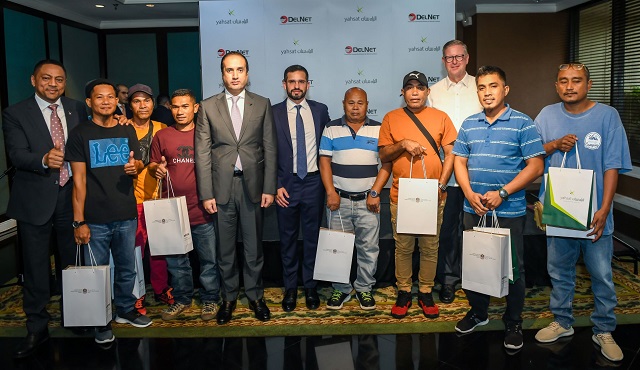Stuck in the Celebes Sea, seven fishermen aboard a small makeshift boat managed to stay afloat for more than 48 hours until they were able to call for rescue — thanks to their satellite phone.

Altim J. Latip and six fellow fishermen were on their way to Jolo from Tawi-Tawi when their newly purchased second-hand boat was struck and damaged by a big wooden log near Pata Island.
“There is no mobile signal there, but luckily, we brought our satellite phone,” Latip said.
Even without mobile signal, Latip’s SmartSAT XT Lite — a handheld, lightweight satellite phone powered by Thuraya and PLDT wireless unit Smart Communications — was able to give out their longitude and latitude details and enabled them to relay their situation to the Philippine Navy and Coast Guard.
Over the course of two days, Latip and his crew watched as big foreign boats came and went without rescuing them.
“But we held onto hope. As long as our Thuraya XT-LITE satellite phone still had battery, we could give out our position to the Navy and the Coast Guard,” said Latip.
With him were Benhar S. Idanny, Jimmy M. Sakilan, Abennaser A. Bandahala, Rolly B. Posadas, Nizar B. Haiber, and Hamid T. Sahabat.
Eventually, a Japanese vessel managed to rescue them, after receiving their final coordinates before their satellite phone’s battery finally ran out.
“Thank you to Thuraya and Smart. You saved our lives,” Latip said. Latip and his fellow fishermen’s story highlights how satellite communications can help in crisis situations.
“Smart has a long history of innovation in providing satellite services to Filipinos, including fishermen and seafarers like Latip and his men,” said Mitch Locsin, first vice president and head of enterprise and international business groups of PLDT and Smart.
“Hand in hand with partners like Thuraya, we at the PLDT Group continue to empower communities and businesses, especially in crisis situations like this.”
In 2013, Smart entered into a strategic partnership with mobile satellite services provider Thuraya Telecommunications Company, which expanded Smart’s satellite coverage to over 160 countries or two-thirds of the world, including major sealanes in Asia, New Zealand, Australia, Middle East, Africa, Europe, and the Indian Ocean.
“Access to satellite communications can spell the difference between life and death in certain situations. The SmartSAT XT Lite is an easy-to-use, stand-alone satellite phone that can make phone calls and send text messages in satellite mode, supported by the most robust and powerful satellite network,” said John Eric Alviz, vice president and head of wireless core and international business group at Smart, adding that the phone’s high battery capacity also proved crucial to Latip and his companions’ rescue.
Smart’s longstanding initiatives in satellite communications includes the Asia Cellular Satellite (ACeS) system-based Smart Tawag Center public calling office launched in 2001, which made possible domestic and international voice services in remote areas, and Smart Link, the Philippines’ first prepaid wireless satellite phone service.
Smart Link provided affordable call rates to hundreds of thousands of Filipino seafarers, allowing them to have a direct line to their families back home in the Philippines even while months at sea.

Satellite communications have also served as vital lifeline in extreme scenarios, such as super typhoon Yolanda in late 2013, which toppled power and communication lines and rendered many parts of Eastern Visayas out of reach for days except through the use of satellite devices.
Knowing it had to make satellite services more accessible to Filipinos, Smart launched SmartSAT in early 2014 to bring the benefits of satellite communications to a broader consumer market beyond the maritime industry.
SmartSAT gave users access to voice calls, emails, text messages, and data services in areas with compromised or difficult cellular coverage.
Today, SmartSAT continues to serve individuals and communities in critical and demanding fields such as the media, the military, adventure tourism, and the country’s disaster and emergency response agencies, as well as to business groups and even private entities who need the security of having a back-up or enhanced mobile coverage, for extreme scenarios when everything else breaks down.
In 2021, SmartSAT devices were also used to help quickly reconnect Cebu, Dinagat, Siargao, and Surigao in the immediate aftermath of super typhoon Odette, providing vital communication links for local officials and response teams conducting rescue, relief and recovery in these badly hit areas.




